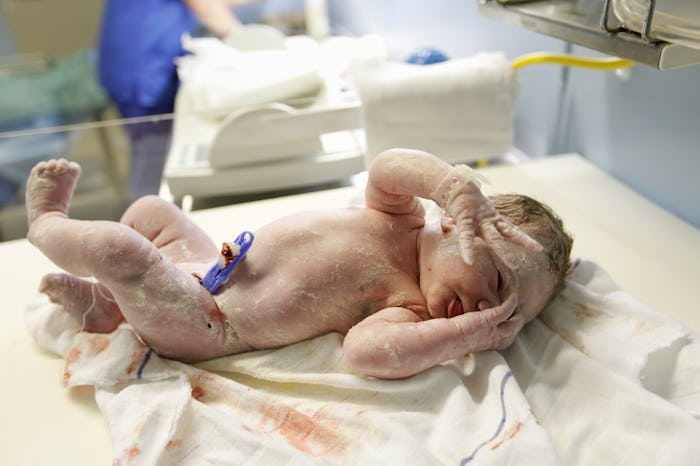Life

Here's What Every Pregnant Woman Should Know About Her Baby's Cord Blood
The mysteries of childbirth never cease to amaze. Between the ways our bodies expand to accommodate a growing fetus, the intricate system that creates and delivers breast milk, and the actual birthing process itself, our bodies are truly amazing in every sense of the word. This is especially true regarding some of the lesser known pieces that make up the pregnancy, labor, and childbirth puzzle. Yes, I'm talking about cord blood. So, what is cord blood? In short, cord blood — blood that is stored in the umbilical cord after cutting — can save lives, so it's absolutely worth learning about before you cut the cord that ends pregnancy and signifies the start of parenthood.
Typically, cord blood is collected by clamping the umbilical cord, then cutting the cord within a specific amount of time and only if there's no immediate emergency that could potentially put your life or the life of your baby in jeopardy. While you enjoy holding your new baby for the first time, a designated nurse will use a needle to extract the blood from the umbilical cord and place it into a collection bag. The extraction doesn't hurt you or your baby, and the whole process takes about 10 minutes, according to BabyCenter.
The reason cord blood is so vital, according to BabyCenter, is because it contains powerful stem cells that may evolve into red or white blood cells and platelets. This is interesting because, unlike other types of cells in the body, these stem cells — called hematopoietic stem cells — can treat a wide array of conditions, including (but not limited to) some cancers. The American Congress of Obstetricians and Gynecologists add that while it's easier to collect cord blood for the possible treatment of such disorders (rather than bone marrow, for example), there typically aren't many stem cells present in just one umbilical cord. As a result, the utilization of several are combined in order to fulfill a potential transplant need.
Though controversy surrounds the use of stem cells for various reasons, the National Cord Blood Program claims scientists are looking into ways the cord blood stem cells can actually replace the cells of other tissues. If successful, this could be life-saving for many previously untreatable diseases. In fact, the March of Dimes reported that every year, over 10,000 people are diagnosed with life-endangering diseases. The stem cells from cord blood may help treat the more than 70 diseases and disorders. That's a lot of power with a small amount of cord blood. The American Society of Clinical Oncology reports that more than 25,000 transplants have been made possible thanks to the use of cord blood.
Whether or not you choose to extract and bank your baby's cord blood is entirely up to you, of course, but there's no question that it has substantial benefits. It's just another amazing component of pregnancy that can help others long after your baby is born. According to KidsHealth, banked cord blood can be "potentially useful for treating diseases that require stem cell transplants, such as certain kinds of leukemia or lymphoma, aplastic anemia, sever sickle cell disease, and severe combined immunodeficiency." If you choose to donate your child's umbilical cord blood, KidsHealth goes on to explain that there are both private and public banks you can donate to. "Public banks collect donated cord blood for research or for use by anyone who may need it," while private banks "store cord blood for personal use by the family." Every bank is regulated by the U.S. Food and Drug Administration (FDA).
The next time the topic of cord blood is brought to your attention, just remember it's already part of the umbilical cord, and could potentially save lives — including your own.